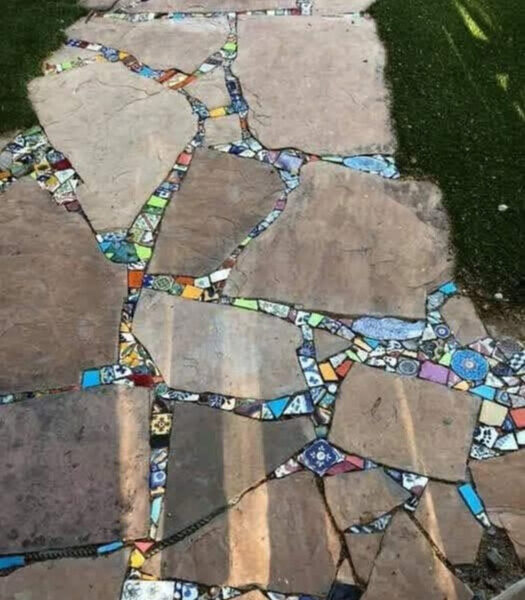
For twenty years, the china cabinet in my dining room was more than furniture — it was a museum of my life. Each plate held a memory. Each teacup carried a story. Each dish marked a moment of joy, celebration, or love.
And then, one afternoon, in the middle of my daughter’s manic episode, all of it shattered.
I heard the crash before I understood what was happening — the sharp, splintering explosion of glass and porcelain raining onto the floor. By the time I rushed into the kitchen, she was standing barefoot among the wreckage, tears streaking down her face, her hands shaking as if the world were cracking open beneath her feet.
She looked at me with wild, terrified eyes — eyes that no longer recognized me, or themselves — before the paramedics gently took her by the arms and led her outside for another 72-hour psychiatric hold.
And just like that, she was gone.
And I was left alone in a room full of broken pieces.
The Sound of Breaking Things
People assume heartbreak comes quietly. Mine didn’t.
It screamed. It split open. It scattered itself across the tile in tiny white and blue fragments.
I sank to the floor, my knees hitting the cold tile as I stared at the destruction. My wedding-shower dishes. The Christmas plates we used every year. The porcelain bowl from my mother. The tiny teacup my daughter bought me when she was eight — pink flowers, a crooked gold rim.
Twenty years of loving, collecting, holding onto moments… all of it shattered.
My neighbor came in after the ambulance left. She looked at the mess, then wrapped an arm around me.
“Just throw it away,” she whispered. “Sometimes you have to start over.”
But I couldn’t.

These weren’t just dishes.
They were chapters.
They were us.
So instead, I got a broom, swept everything carefully into boxes, and stored them in the garage — where they sat for months, untouched, like an open wound sealed inside cardboard.
A Crack That Would Not Heal
My daughter’s diagnosis was a long, complicated journey: bipolar I with psychotic features. Something we didn’t understand for years. Something she didn’t accept for years. Something that pushed and pulled us both through storms we never wanted to face.
She came home between episodes — sometimes stable, sometimes fragile. Each time I held her, I wondered how many more pieces of her life I’d lose before she finally found her way back to herself.
And every time I walked through the garage, the boxes of broken china stared at me. Quiet. Heavy. Patient.
They reminded me of her.
They reminded me of me.
Both cracked.
Both waiting.
The Idea That Changed Everything
One morning, I stepped outside and noticed the walkway leading to my front door — cracked, uneven, tired-looking. For months I had avoided it, just as I’d avoided the boxes. But that day, something tugged at me.
What if… I used the broken pieces?
What if something beautiful could come from what hurt?
The idea seemed ridiculous at first. Who turns disaster into art? Who turns heartbreak into a path? But then I remembered an artist I had met on Tedooo — a woman who created breathtaking mosaics from shattered ceramic.
I reached out to her, half embarrassed, half desperate.
When I told her my story, she didn’t pity me. She didn’t say “I’m sorry.” She said:
“Let’s make beauty from the broken.”
A week later, a box arrived at my door filled with grout, sealant, tools, and a handwritten note that said:
“Every piece matters, even the tiny ones.”
I cried when I read that.
Because she wasn’t talking about dishes.
She was talking about my daughter.
She was talking about me.
The Path I Built With My Hands
For three weeks, I worked on my knees in the dirt.
I cracked open the boxes, spilling the memories across the ground — not as a tragedy this time, but as a beginning.
Piece by piece, I arranged the fragments into patterns. Soft blues curling into whites. Tiny blossoms forming new shapes. Gold edges catching the sunlight in a way they never had before.
Neighbors stopped by and asked what I was doing.
“Healing,” I said.
Some days, I cried as I worked. Some days, I whispered apologies to the shards. Some days, I held the pink teacup — my daughter’s gift — in my hands for long minutes, wondering if it still meant the same thing.
When I finally placed it near the center of the mosaic — not perfect, not whole, but present — something inside me shifted.
It didn’t hurt as much to breathe anymore.
The Day She Came Home
When my daughter returned from her treatment program, she was calmer. Clearer. A little fragile around the edges, but steady.
She walked up the driveway carrying her bag — and then she stopped.
“Mom,” she whispered, staring at the mosaic walkway beneath her feet, “did you… make this?”
I nodded, wiping my dusty hands on my jeans. “From the dishes,” I said softly. “From what was broken.”
Her eyes filled instantly. She knelt down, tracing the familiar pattern of the teacup she’d given me all those years ago.
“You didn’t throw it away?” she asked.
“No, sweetheart. I never would.”
She wiped her cheeks quickly, embarrassed, but I sat down beside her and pulled her close. Her head dropped onto my shoulder. Two broken, mending hearts breathing in sync.
“I’m sorry,” she whispered into my shirt.
“I know,” I said. “And we’re going to be okay.”
For a long moment, neither of us moved.
Just sunlight on porcelain.
Just forgiveness in the air.
Just a quiet understanding that some things don’t get fixed —
they get transformed.
What Remains
Today, the walkway gleams like stained glass under the morning sun. Neighbors still stop to admire it. Strangers ask where I bought it.
But I don’t tell them the real story unless they ask gently.
Because this isn’t just mosaic.
It’s memory.
It’s motherhood.
It’s resilience.
It’s proof that:
We are not ruined by what breaks us — we are remade by what we choose to do with the pieces.
My daughter is healing. Slowly. Bravely. Honestly. Some days are hard, but none of them are hopeless. She walks that mosaic path every morning when she leaves the house — a reminder that nothing is too shattered to become something beautiful again.
Not china.
Not hearts.
Not people.
And sometimes, the most breathtaking things in life aren’t the ones that stay whole —
but the ones rebuilt with love, piece by fragile piece.




